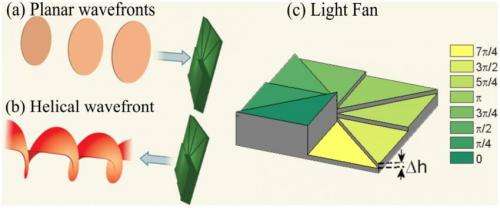June 25, 2014 feature
Spiral-shaped 'light fan' adds new twist to laser-driven plasma accelerators

(Phys.org) —For the past few decades, physicists have been studying the phenomenon of "twisted light," which is light that is twisted like a corkscrew along its axis of travel. Due to the twisting, the light waves at the center of the axis cancel out, resulting in a ring of light with a dark spot in the center. Although it may sound like somewhat of a novelty, twisted light has applications in laser-driven plasma accelerators and plays a role in several astrophysical phenomena such as pulsars, the extremely dense stars that emit light while rotating, somewhat like a lighthouse.
While several methods exist for generating twisted light, physicists in a new study have demonstrated for the first time in simulations the possibility of generating relativistic twisted light. Writing in Physical Review Letters, Yin Shi, et al., at the Chinese Academy of Sciences in Shanghai, China, describe this type of light as a spiral-shaped "light fan."
As the physicists show in 3D simulations and analytical modeling, a light fan can be generated by using a relativistic laser pulse. When this laser pulse impinges upon a thin spiral-shaped foil target, a spiral-shaped plasma is created. This is the relativistic light fan, which is characterized by a very strong torque and very high orbital angular momentum. Both the photons and the electrons in the light fan rotate due to the high orbital angular momentum, which can be either clockwise or anticlockwise. The scientists expect that experiments based on these simulations can be realized soon with current technology.
"Relativistic twisted light is a twisted light with an intensity that is so large that an electron moves in a velocity close to the speed of light," coauthor Baifei Shen at the Chinese Academy of Sciences told Phys.org. "Relativistic light has opened new research fields in high-field physics, including laser acceleration and relativistic high-order harmonics, because it has a high energy density. Now, relativistic twisted light has high angular momentum density, which may result in many new physical phenomena."
The light fan's high angular momentum density may make it very useful for several applications. For example, in laser-driven plasma accelerators, the accelerating force has traditionally been the main point of interest since it is the origin of particle acceleration. However, having a high torque can also be important, although it has not been given much attention so far.
"Relativistic twisted light can be used for positron and proton acceleration in the bubble regime, since the driven doughnut wakefield has a transverse focusing force for positively charged particles so that they can be accelerated for a long distance," Shen said. "The light fan is a rotating structure of large angular velocity, which is due to the conservation of angular momentum. Because the normal light has no angular momentum and the reflected twisted light has angular momentum, the light fan must have opposite angular momentum."
Relativistic twisted light with a strong torque could also be used to mimic some astrophysical environments such as pulsars, leading to a better understanding of these unique and distant stars.
More information: Yin Shi, et al. "Light Fan Driven by a Relativistic Laser Pulse." Physical Review Letters 112, 235001 (2014). DOI: 10.1103/PhysRevLett.112.235001
Journal information: Physical Review Letters
© 2014 Phys.org





















